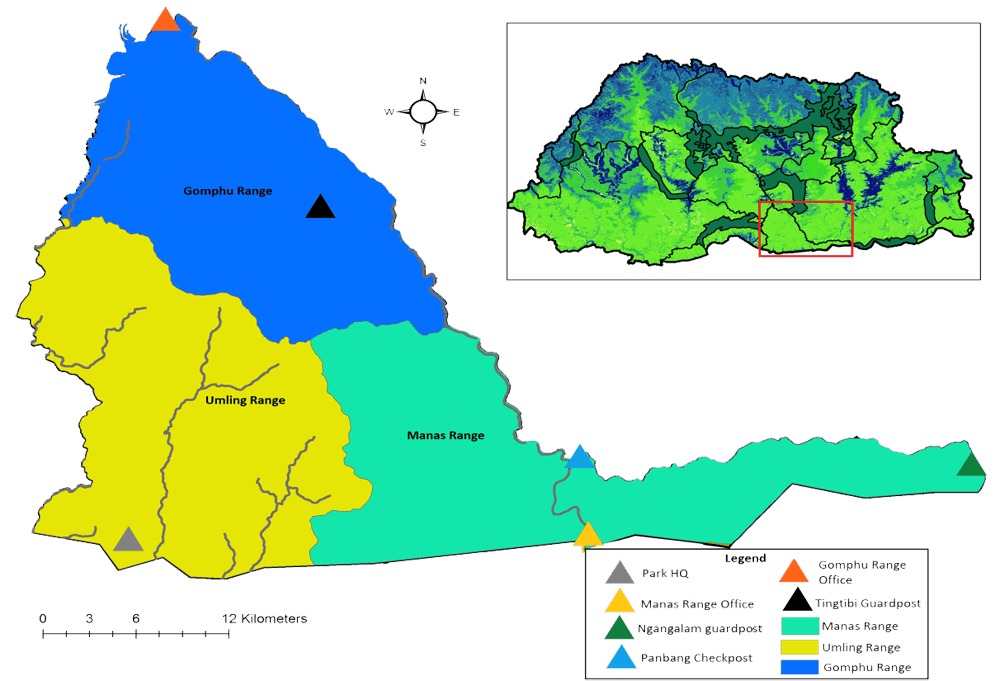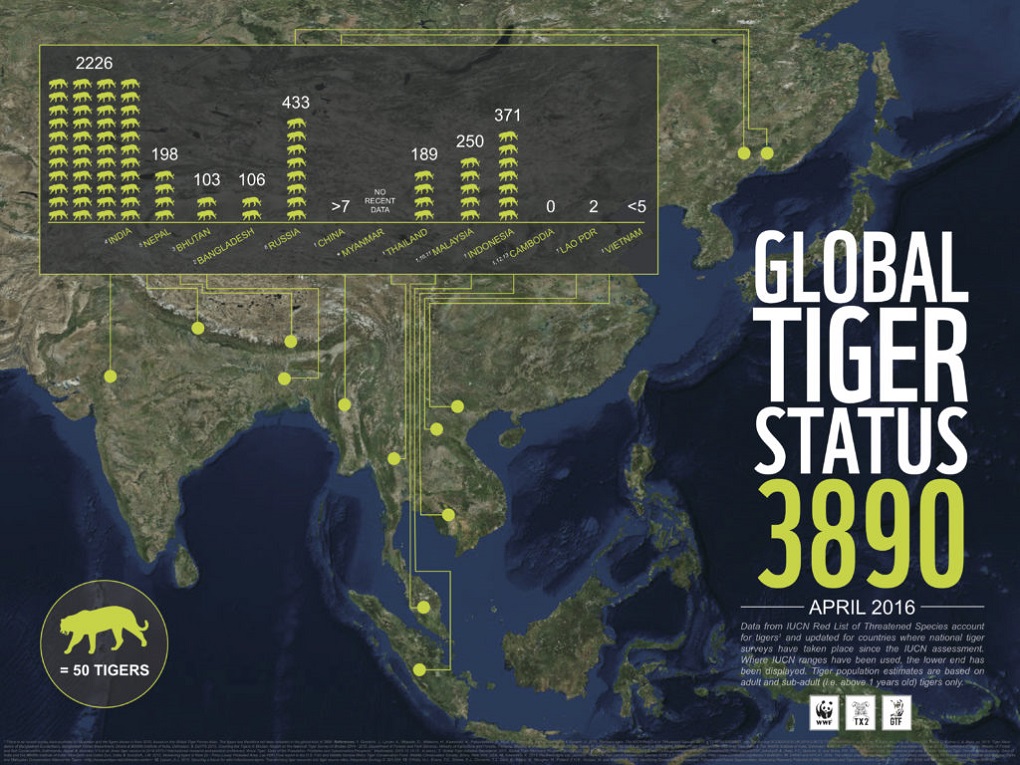The tiger population is slowly growing in the tiny Himalayan kingdom of Bhutan. New tiger photographs and pugmarks have emerged from different parts of the country, indicating an overall increase in their numbers.
The Royal Manas National Park, one of Bhutan’s oldest parks located in south central Bhutan, saw its tiger population double from 10 to 22 tigers, between 2010 and 2016. A total of 90 camera stations, each with two cameras were installed across 1,300 square kilometers in Manas. According to latest data analysis, the number had increased to 28 tigers in the park by 2018, based on the same camera that had been used for earlier surveys.

Why have Bhutan tiger populations increased?
Deputy chief forestry officer of the Royal Manas national park, Sithup Lhendup said that while it is difficult to ascertain whether the number of tigers has increased due to migration or new birth. However, from what has been observed so far, it is safe to say that around 50% is due to migration and the remaining half are new births. His team is carrying out an analysis on age structure and population dynamics which will give a clearer idea of how many tigers have migrated into Bhutan.
According to the World Wildlife Fund Bhutan, 12 transboundary tigers have been recorded in the Transboundary Manas Conservation Area in 2015, an increase from just four tigers in 2011, according to the latest report on tigers of Transboundary Manas Area.
Bhutan conducted its national tiger survey in 2014-15, which estimated 103 tigers. With the latest increase in their population, Bhutan is well poised to contribute to the global ambition of doubling tiger population by 2022.

A multi-pronged approach
Proper trans-boundary cooperation with India, anti-poaching, habitat conservation and awareness among farmers has paid off, along with the successful implementation of the Tiger Action Plan.
At home, the government has also stepped up its plans and policies to conserve tigers. Bhutan’s 12th five year plan and the Bhutan for Life Initiative have set an ambitious target to increase tiger population by 20% in the next five years.
To improve tiger habitats, the 12th five-year plan includes activities such as removal of invasive weeds, controlled burning, creation and maintenance of water holes and enriching plantation.
Another big initiative for the conservation of tigers in Bhutan was the establishment of the National Tiger Center last year in the southern district of Gelephu, which borders India, with its primary focus on the conservation of the iconic species.
Environmentalists and conservationists attribute the increase in tiger numbers to the environmental policies of the government, tolerance of farmers, and a commitment from the officials on the ground. Much of this rests on the historical and cultural value of tigers in Bhutan, which are considered symbols of luck in the predominantly Buddhist country. Tigers have featured in Buddhist literatures that date back to the 8th century.
One big advantage for Bhutan is habitat. Bhutan’s constitution mandates a minimum of 60% forest cover (it was 71% in 2017) while 51% of the country’s land is a mix of protected areas and biological corridors. Kuenley Tenzin, assistant program officer with WWF Bhutan, said Bhutan wants to not just save tigers, but to make it a safe haven for the endangered cat.
Tiger conservation is a top priority for Bhutan not just because of the iconic mammal, but also a measure of how the larger ecosystem is doing. A healthy number of tigers in the forests also work to keep a natural check on herbivores.
The overall tiger population in Bhutan is already fairly healthy. According to Tshering Tempa, program director of the National Tiger Center said, there are already at least 103 tigers in the country, but Bhutan’s forest could support between 200 to 250 tigers.
The previous national survey in 2015 found that tigers in Bhutan were mostly concentrated in certain areas in the country. Tigers from the northern parts of the country were not sighted in the south and vice-versa.
However, latest studies show that tigers have been moving across vast distances in Bhutan. In 2015, an adult male tiger spotted in the Manas National Park, in southern Bhutan, was sighted in northern Bhutan at an elevation of 4,000 meters.
Lethro, a senior forestry officer with the nature conservation division of the ministry of agriculture and forests, said this means that Bhutan’s biological corridors are well functioning. For tigers to move around freely there should also be uniform occupancy of prey across the country, and so the movement also indicates a healthy herbivore population.
Tiger density in Bhutan is higher in the south then in the north, but that is not because of a lack of proper habitat or prey in the north. The nature conservation department would be happy to see more tigers moving north. “Since tiger density is higher in the south, there are also risks of over population,” Lethro added.
Tiger poaching remains a threat
Poaching is still considered one of the biggest threats to tigers in Bhutan. The same tiger that was spotted in northern Bhutan had later returned to Manas where Indian poachers killed it. Bhutanese officials were able to confirm this after examining the tiger’s stripes.
To reduce such instances, SMART (Special Monitoring and Reporting Tool) Patrolling is now being implemented throughout the country including in protected areas.
Sithup Lhendup said, most of the poaching incidences go unreported but the cases are very high. To curb poaching, synchronized patrolling with Indian counterparts has been initiated two years ago. “We have also increased the number of patrolling days to 20 days every month.”
Transboundary and global cooperation
A transboundary meeting between the Royal Manas National Park and Manas National Park India was held in 2008 to promote join anti-poaching program across the border to curb smuggling of timbers and wildlife trade. The workshop was regularised in 2012, and the number of stakeholders increased. By 2013 there were 14 stakeholders from India (9 government agencies and 5 NGOs) and 10 stakeholders from Bhutan including WWF Bhutan.
Sithup Lhendup said Bhutan and India were cooperating at multiple levels, with research on development, with Indian NGOs such as Aranyak ecological society, and at the protection and preservation level with the Indian Manas Tiger Reserve. He said a joint patrolling is also carried out by both Indian and Bhutanese officials in the ground. Cooperation has significantly improved today, as there is no insurgency in Northeast unlike in the past, which has improved security, for both humans and wildlife.

Bhutan is a member to the Tx2 Initiative where 13 tiger-range countries have committed to double tiger population by 2022 from what it was in 2010. 2022 will the next Chinese Year of the Tiger.
As a member of the 13 tiger range countries, Bhutan’s conservation efforts and programs are well established. “We may not be able to double Bhutan’s tiger population, but will contribute significantly to the global effort.” Lethro said.
The world tiger population is today estimated at around 3,900.
![<p>A wild Bengal tiger [Image by: Mark Smith/Alamy]</p>](https://dialogue.earth/content/uploads/2015/01/wild-tiger-scaled.jpg)







